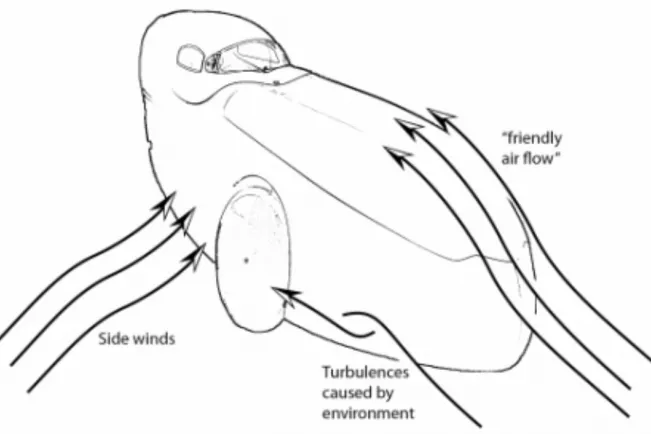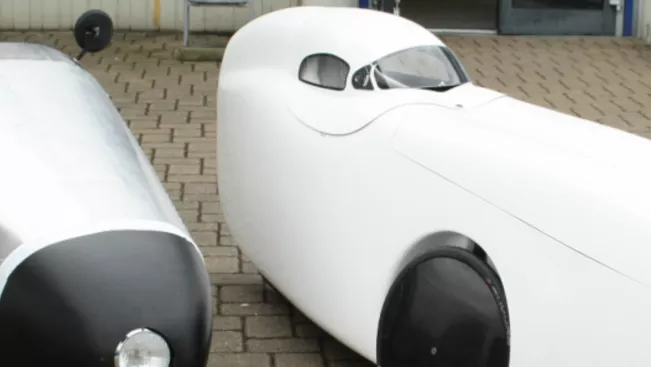DoVE

Research project at a glance
Departments and Instituts
Period
24.09.2014 to 24.02.2018
Project manager at H-BRS
Project Description
The goal of the Development of Vehicle Exteriors (DoVE) project is to explore new techniques in the automated engineering of three dimensional objects. We take the crafting of the aerodynamic shells which surround velomobiles as a test case, using evolutionary methods to develop stable, aerodynamic, light-weight designs.

Typically engineers, using well understood rules and decades of experience, create designs which they know will perform well, and validate these designs, either through wind tunnel tests or fluid dynamics simulations. As computing power grows and evolutionary algorithms become more sophisticated engineers are increasingly taking advantage of these algorithms to further optimize their designs. Engineers identify particularly important parameters, such as the angles of the body at the back of a car, and allow these algorithms to test out many variations of these parameters within a predefined range. Those designs which perform the best are combined, along with some small random changes to produce new ‘child’ designs, the best of which in turn are evaluated and produce their own ‘child’ designs. This mimicking of survival-of-the-fittest iteratively produces ever better designs, without the expert knowledge, or prejudices, of human engineers.
In contrast to the development of automobiles and airplanes by large firms and teams of engineers, the story of velomobile design is mostly one of hobbyists and small companies. The trial and error experimentation of these smaller designers has developed incredibly high performing vehicle shells, the shapes of which are very non-intuitive. The Milan velomobile is one such design, with a complex, contoured shape. The success of these oddly shaped designs suggests intriguing possibilities for new design concepts outside of established engineering experience.
For an algorithm to produce non-intuitive designs like the Milan it is obvious that we cannot only concentrate on small adjustments in predefined parts of existing designs. Instead the shape must be able to be changed in its entirety. Very large numbers of parameters must therefore be tuned, all of which interact. To do this we use techniques pioneered for the evolution of highly complex neural networks. These techniques have been shown to be effective in the evolution of networks with interacting parameters in the millions, and so are suitable for describing three-dimensional shapes, even at very high resolutions. Advances made in more complete representations of three dimensional objects, and their optimization, could then be applied beyond aerodynamics and to a wide variety of engineering problems.
DoVE-Tales: Real World Drag Testing
Light-weight vehicles, like pedelecs or velomobiles, are usually designed by experts and tested in computational fluid dynamics (CFD) simulations of the vehicle body, or by subjecting a real world model to a series of wind tunnel tests. Wind tunnel tests offer a fully controllable test bed but lack the ability to test factors common in realistic environments. A fully realistic environment, with such effects as side winds, road architecture, and externally caused turbulences, is necessary to produce a more accurate efficiency model of the vehicle over its entire lifetime.

Wind tunnels tend to produce highly idealized scenarios with a dominant air flow direction and little externally caused turbulences. On the other hand, CFD simulations offer ways to simulate more realistic environmental conditions, but they come at a high computational cost and a reduction of accuracy, which is caused by the approximative nature underlying the CFD setup. The incomplete model for turbulent air flow and the relatively low data resolution in CFD systems leads to such a loss in accuracy.
To create a more realistic test bed for vehicle testing, DoVE-Tales is developing solutions to extract an air flow model around such vehicles by using techniques from computer vision and machine learning. By attaching so-called ‘tufts’, commonly made out of yarn or wool, to well described basic shapes in a wind tunnel, and by using image analysis to extract their positions, orientations and deformations over time, we learn how to map these properties to the actual air flow around the objects. We can then transfer the tufts and the visual system to a real vehicle and run outside tests over predefined scenarios. The machine-learned mapping will then provide us with a full air flow model during these tests. This will enable us to do comparative testing between vehicle models and analyze how small changes in the vehicle’s chassis improves or degrades aerodynamic efficiency.
Tufts are commonly used for qualitative analysis and are widely used to determine flow separation and transition layers between laminar and turbulent air flow. Quantitative analysis is a much more difficult problem, and while it has been shown to be possible in idealized scenarios through the use of smoke and infrared lasers, enabling this technology for full-body analysis in realistic scenarios will provide new insights into the vehicles’ design and behavior.
Results
Theses and Projects
- Alexander Hagg: Hierarchical Training of Local Surrogate Models for Evolutionary Optimization of Streamlined 2D Shapes, Masterarbeit, work in progress
- Michael Wahlen: Ableitung eines zeitvarianten Vektorfeldes aus Tuft-Videos, Masterarbeit, 2015
- Arka Mallick: Estimating air speed around aerodynamic shapes based on tuft behavior, Research&Development Projekt, 2015
Publications
- Adam Gaier: Evolutionary Design via Indirect Encoding of Non-Uniform Rational Basis Splines, Proceedings of the 2015 Annual Conference on Genetic and Evolutionary Computation Pages 1197-1200 , ACM New York, NY, USA, 2015